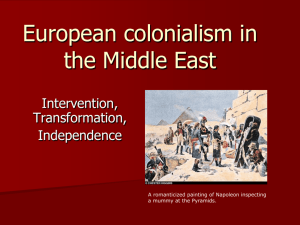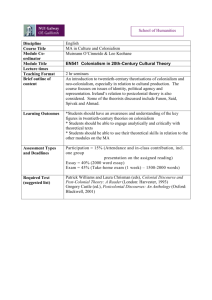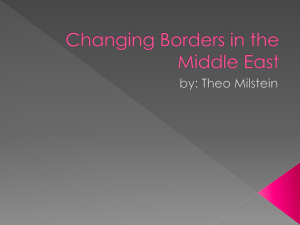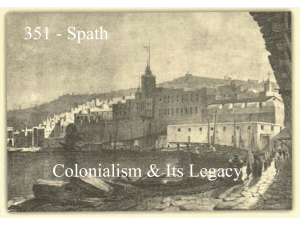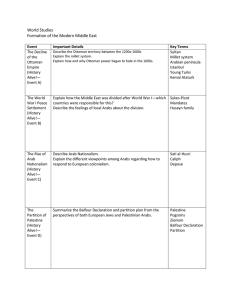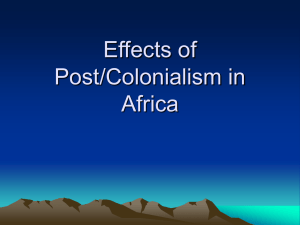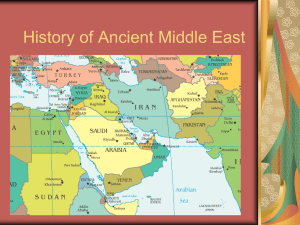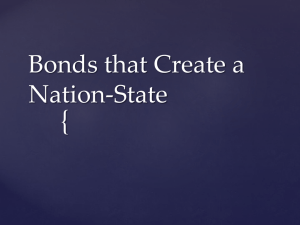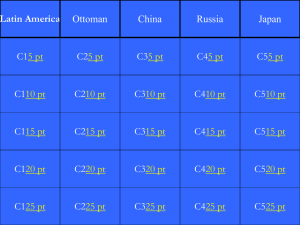Colonialism in the Middle East, powerpoint
advertisement
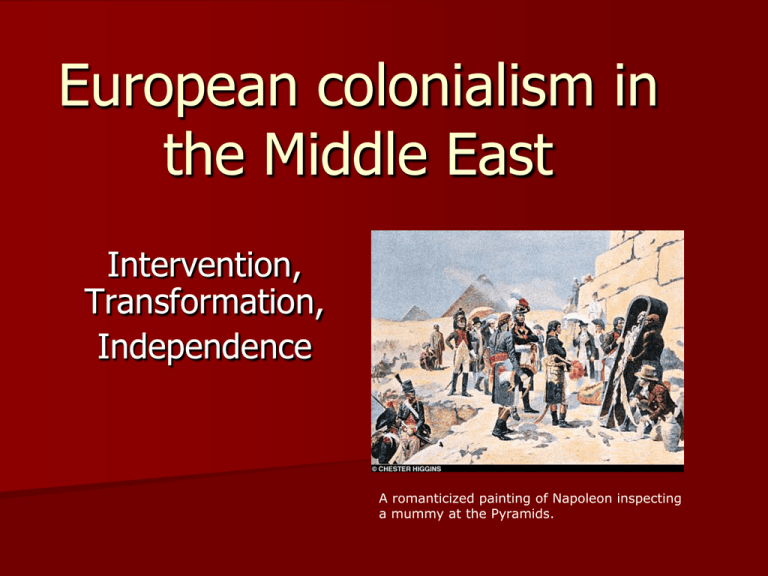
European colonialism in the Middle East Intervention, Transformation, Independence A romanticized painting of Napoleon inspecting a mummy at the Pyramids. Responses: Transformations in Ottoman rule Ottoman reform: 1830s-1870s – New centralization – New technologies (railroad) – New education – New institutions Erosion of Ottoman economic and political independence – Capitulations European protection of non-Muslim minorities Nationalism – loss of Ottoman territories in Europe – Turkish and Arab nationalism The Age of Empire, 1875-1914 Growing global division between the very powerful and the less powerful Rise of colonial empires – Between 1876 & 1914 about 25% of the world’s land surface distributed as colonies among European powers – Reasons: economics (new markets & new resources), strategic reasons, political symbolism, nationalism European colonialism in the Middle East, late 18th-late 19th c. – 1798-1801 French invasion of Egypt – British outposts on the Arabian Peninsula, 1799 – French annexation of Algeria, 1834 (settler colonialism) – British administrative occupation of Egypt, 1882 – Russian and British imperialism in Iran Gerome’s Napoleon in Egypt (1863) European colonialism in the Middle East, 20th century WWI and Competing promises: – Husayn-McMahon Correspondence, Sykes-Picot agreement; Balfour Declaration – • Promised Palestinian Arabs independence if they helped beat the Turks in World War I. – • Promised Jews a homeland Post WWI: League of Nations-sanctioned Mandate System gives Britain and France administrative control of Palestine, Transjordan, Iraq, Syria, & Lebanon Many other areas remain under direct or indirect colonialism Issues with Colonialism Religions: Judaism, Islam, Christianity Languages: Arabic, Turkish, Persian, Hebrew, Kurdish, Armenian Borders: created by European nations without thought to ethnic makeup of the region Sykes-Picot Agreement Gaining Freedom Nationalism: Independence was gained in the following years: – 1923 – Trans-Jordan from Britain – 1930 - Iraq gained freedom from British; borders gave limited access to Persian Gulf and religious and ethnic tensions prevailed – 1936 - Egypt independence from Britain, but military control of the Suez Canal for Britain for 20 years – Lebanon, Syria, Jordan gained independence after World War II – Pan-Arab dream was to create a united Arab state The Mandate System certain parts of the world put under “trusteeship” of various victorious European powers British mandates in the MidEast: Palestine, Iraq, Transjordan French mandates in the MidEast: Syria, Lebanon Mandates both sanctify western colonialism but also circumscribe it ARTICLE 22 OF THE COVENANT OF THE LEAGUE OF NATIONS June 28, 1919 1. To those colonies and territories which as a consequence of the late war have ceased to be under the sovereignty of the States which formerly governed them and which are inhabited by peoples not yet able to stand by themselves under the strenuous conditions of the modern world, there should be applied the principle that the well-being and development of such peoples form a sacred trust of civilization and that securities for the performance of this trust should be embodied in this Covenant. 2. The best method of giving practical effect to this principle is that the tutelage of such peoples should be entrusted to advanced nations who by reason of their resources, their experience or their geographical position can best undertake this responsibility, and who are willing to accept it, and that this tutelage should be exercised by them as Mandatories on behalf of the League. 3. The character of the mandate must differ according to the stage of the development of the people, the geographic situation of the territory, its economic conditions and other similar circumstances. Outside the Mandate True independence: Turkey Mostly independent: Yemen, S. Arabia Direct colonial rule: Libya (Italy); Algeria, Morocco, Tunisia (French) External control & influence: Iran (Britain, Russia, U.S.), Egypt (Britain) British treaties of protection: Kuwait, Oman, U.A.E. Map Correction: Iran and Egypt were not fully independent until much later than indicated here. Both continued to have extensive external involvement in their economic and political affairs. Full Independence: How and When Military Coup: Egypt (1952), Iraq (1958) Revolution: Iran (1979) War: Turkey (1920-1923), Algeria (1954-1962), Israel (1948) Uprising and Int. Agreement: Libya, Syria, Lebanon (after WWII) Treaty: Jordan (1946/8), Tunisia (1956), Morocco (1956) Communities promised states/autonomy that did not receive them: Palestinians, Kurds, Armenians Colonialism: Overarching effects Creation of new, national states in place of the Ottoman Empire (Iraq, Jordan, Israel, Turkey, etc.) Implanting of western-supported regimes (especially monarchies) that use violence to maintain authority. In many cases, these would later be violently overthrown. Centralization of political power. Loss of rural autonomy. Reorganization of social relationships among different groups. Privileging of some religious and social groups over others, leading to future conflict. Massive economic disruption. New economic relationships, with arrangements particularly benefiting western powers New models: nationalism, “modernity vs traditional” Colonialism & Imperialism, summed up (a perspective)
